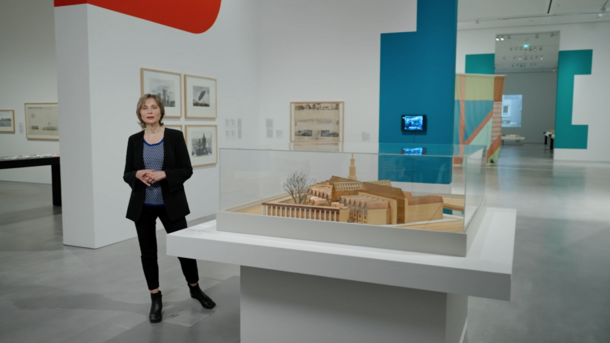Widely labelled “postmodern”, it drew on structural typologies and stylistic devices from the past and tested alternative urban lifestyles. In the run-up to the celebrations marking 750 years since the original town charter, the entries submitted to the “Internationale Bauausstellung” in West Berlin in 1984/87 and the “Bauausstellung” of 1987 in East Berlin turned the city into a kind of architectural laboratory observed from well beyond its boundaries. Even at the design stage, some were already attracting criticism as artistically misguided, and significant examples of this era in architecture have since disappeared, been revamped or else threatened by demolition.
This exhibition is the first attempt to show who and what set their stamp on the buildings and visions developed for East and West Berlin in the final decade before the Wall fell. Installations by artist Isa Melsheimer and the Guerilla Architects offer a contemporary perspective on the postmodern architectures on show. A free web app with listening walks around the city leads past selected buildings from the 1980s.
Trailer
Digital options
Out into the City!
Audio Walk App for the exhibition "Anything Goes? Berlin Architecture in the 1980s"
Revisited. Visiting Apartment Buildings of the 1980s
A project by the Guerilla Architects
Artists/Architects list (A–Z):
Raimund Abraham, Dieter Andree, Inken Baller, Hinrich Baller, Dietrich Bangert, Dieter Bankert, Horst Bartnig, Cynthia Beatt, Klaus Bendler, Sibylle Bergemann, Dietrich von Beulwitz, Hélène Binet, Wolfgang Bittner, Thomas Bomm, Bernhard Brabetz, Gianni Braghieri, Siegfried Büker, Andrés Duany, Peter D. Eisenman, Wolf Rüdiger Eisentraut, Christian Enzmann, Fritz Eschen, Bernd Ettel, Harun Farocki, Axel Finkeldey, Reinhard Friedrich, Dieter Frowein, Meinhard von Gerkan, Ernst Gisel, Ehrhardt Gißke, Robert Göllner, Burkhard Grashorn, Vittorio Gregotti, Guerilla Architects, Jasper Halfmann, John Hejduk, Jürgen Henschel, Herman Hertzberger, Steven Holl, Hans Hollein, Johannes Peter Hölzinger, HPP Architekten, Arata Isozaki, Helmut Jahn, Jochen Jentsch, Jochem Jourdan, Edmund Kasperski, Kain Karawahn, Hermann Kendel, Josef Paul Kleihues, Michael Kny, Hans F. Kollhoff, Rem Koolhaas, Stefan Koppelkamm, Roland Korn, Rob Krier, Wolfgang Krolow, Martin Küenzlen, Daniel Libeskind, Volkwin Marg, Heinz Mehlan, Isa Melsheimer, Peter Meyer, Harald Metzkes, Charles Willard Moore, Murphy & Jahn, Moritz Müller, Hans-Jürgen Henry Nielebock, Siegfried Nitsch, Novotny und Mähner, Kjell Nylund, Office for Metropolitan Architecture (OMA), Ulrike Ottinger, Frei Otto, Elizabeth Plater-Zyberk, Manfred Prasser, Andreas Prüstel, Christof Puttfarken, Bruno Reichlin, Fabio Reinhart, Rolf Ricken, Peter C. Riemann, Jaquelin Robertson, Aldo Rossi, John Ruble, Sebastian Runge, Barna von Sartory, Matthias Sauerbruch, Christian Schädlich, Gottfried Schenk, Michael Schmidt, Axel Schultes, Peter C. von Seidlein, Álvaro Siza Vieira, Alison Smithson, Peter Smithson, Gerhard Spangenberg, Günter Stahn, Gisela Stappenbeck, James Stirling, Werner Strassenmeier, Peter Stürzebecher, Karl-Ernst Swora, Die Tödliche Doris, Oswald Mathias Ungers, Robert Venturi, Myra Warhaftig, Thomas Weber, Peter Weiß, Michael Wilford, Buzz Yudell, Elia Zenghelis, Zoe Zenghelis, Clod Zillich







